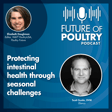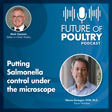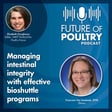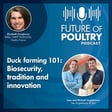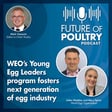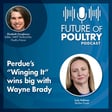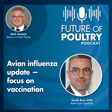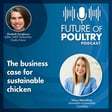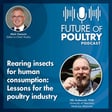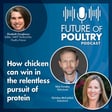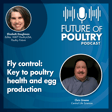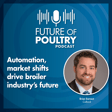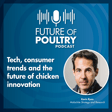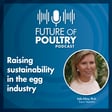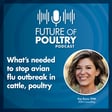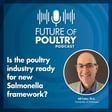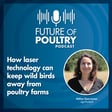Become a Creator today!Start creating today - Share your story with the world!
Start for free
00:00:00
00:00:01

Improving lives through sustainable poultry production
Maureen Stickel, director of international program development with the World Poultry Foundation, joins Mark Clements, editor-in-chief, poultry, WATT Global Media, to look at the organization’s transformative work with small-scale poultry producers.
Transcript
Introduction to the Podcast and Guest
00:00:00
Speaker
Hello and welcome to the Future of Poultry podcast series.
Global Poultry Challenges and WPF's Mission
00:00:12
Speaker
I'm Mark Clements and today I'm joined on the podcast by Maureen Stickle, Director of International Program Development with the World Poultry Foundation or w pf For many of us, poultry, meat, and eggs are something that we take for granted.
00:00:26
Speaker
But for much of the world, this is not the case. And there are various bodies that are seeking to remedy this through helping small-scale farmers to have greater access to not only birds, but also the knowledge and inputs to raise them successfully.
00:00:40
Speaker
This, in turn, improves nutrition, and can help to raise incomes. One such organization is the WPF, which is active in Africa, Asia, and Latin
Maureen Stickle's Role and WPF's Evolution
00:00:49
Speaker
America. And so I'm pleased to have Maureen with us today to tell us about the foundation's work.
00:00:54
Speaker
Maureen, it's great to have you on the podcast. Thank you for finding the time to join us today. Thank you for having me We're excited to have our work featured by Watt Poultry. We follow your news closely and are honored to be here.
00:01:06
Speaker
Before we look at the work of the WPF, could you tell us how it came about, how long it's been running and how you came to be involved with it? So the World Poultry Foundation originally started in the 1990s under a different name.
00:01:21
Speaker
When it started, the focus was on training and supporting the advancement of poultry industries in other countries to really help bring them up to standard. Our original funding came from the U.S. Department of Agriculture, the USDA, as well as several large poultry companies in the United States.
00:01:38
Speaker
Throughout the early 2000s, we continued our focus on training with targeted initiatives in several countries globally, ah Vietnam, Haiti, Ghana, Ethiopia, and others.
00:01:49
Speaker
But then in 2015, we underwent a rebrand and became the World Poultry Foundation, or WPF, as I'll call
Improving Farmers' Lives through Poultry Value Chains
00:01:56
Speaker
it. We've always maintained our focus on training, but we've also expanded our work to really focus on private sector engagement,
00:02:03
Speaker
and developing value chains focused on rural producers, not yet a part of the commercial poultry industry as well. I myself, I've been working with the WPF formally for just over four years, so since 2021, though I did work with the World Poultry Foundation in a consulting fashion for three and a half years prior to that, so since 2018.
00:02:23
Speaker
Within the organization, I wear a few different hats. i developed all of our data systems. I lead our external communications, and then I oversee all aspects of our training work across our programs.
00:02:34
Speaker
So that sounds like a quite a heavy workload, Maureen. Amazing. Could you tell us what are the main aims of the foundation? Our mission is to improve the lives of farmers globally through engagement with poultry value chains.
00:02:47
Speaker
All of our work focuses on poultry, so really on chickens. We work to address the barriers rural farmers face in poultry markets. We create programming to help those farmers so they can improve the productivity of their flocks.
00:03:01
Speaker
More productive flocks lead to more opportunities for increasing income through the sale of meat and eggs, as well as opportunities for improving household nutrition through the consumption of meat and eggs in the household.
00:03:12
Speaker
Because poultry rearing tends to be a female-centric activity in many rural areas, and we also tend to operate in areas where there's a high youth unemployment, there's also many opportunities for us to engage women and youth in our work.
00:03:24
Speaker
Across all of our work, we also strive to be
WPF's Global Programs and Technological Tools
00:03:28
Speaker
sustainable. And here I'm not so much just talking about environmental sustainability, but really we focus on creating programs and spurring economic activity that can outlive our own involvement.
00:03:39
Speaker
We don't want a project to die when we leave. And for that reason, we really focus on training as well as partnership with the private sector. And where are the main areas that you work and and why did the foundation choose those areas?
00:03:52
Speaker
You know, chickens are really a global good. Most countries have some culture of backyard production in rural areas, and poultry is generally a less expensive as well as a less resource-intensive meat to produce.
00:04:05
Speaker
So there's a lot of easy interventions to really improve upon productivity of local birds. And so all of these points combine to really highlight how our work has global relevance. We have worked across the globe. We've worked in over 20 different countries.
00:04:20
Speaker
More recently though, our work has been more concentrated on countries in Africa. We have programs in Western, Southern, and Eastern Africa. And much of that has been really driven by donor interest.
00:04:30
Speaker
I'll note that we've had good success across a range of countries with our poultry multiplication initiative. And that's really giving us confidence as we continue to grow the footprint into new geographies. I want to look at the Foundation's poultry multiplication initiative in detail a little later on in our conversation. But looking broadly at what you do, you offer a whole variety of training programmes, and these are not simply aimed at those rearing birds.
00:04:56
Speaker
That's right. I think the PMI or the Poultry Multiplication Initiative really put our organization on the map, if you will, but our roots are in training. We've often worked with partners to develop targeted training programs, and I can give you a couple of examples.
00:05:10
Speaker
Recently, we led a series of virtual workshops in Cuba on topics related to production, biosecurity, poultry nutrition, and poultry health. We also ran a series of in-person workshops in Ghana with poultry farmers on topics related to on-farm financial management and flop planning.
00:05:28
Speaker
One other example, we worked with a group in Lesotho to develop tailored training manuals for poultry farmers there. So we had three different manuals, one for dual purpose birds, one for layers and one for broilers, incorporating key details to production challenges found in Lesotho, like producing in cold weather or producing at altitude.
00:05:47
Speaker
but at that small or medium scale and in a lower resource setting. And your training materials are offered in wide variety of formats and languages, carefully adapted to the needs of all those who need to be trained.
00:06:00
Speaker
Yes, through all of our work, whenever we develop new resources, we want to share those, especially if they can be helpful to farmers facing similar challenges. So for that reason, we've built out a library of resources on our website.
00:06:12
Speaker
Every resource is free to download and use, and they cover a range of topics related to poultry production, biosecurity, on-farm management, and more. We've also developed different materials to really suit different audiences.
00:06:25
Speaker
So we always focus on that rural small to medium-scale producer But in some locations, who that is might look a little bit different. In some areas, that person might have lower literacy or numeracy.
00:06:36
Speaker
So we have materials available for those audiences too. So we have a whole series actually of visual guides that teach the real basics of poultry care. We work to translate all of those resources as well into additional languages so they're more accessible.
00:06:50
Speaker
I think the visual-based guides are now available in over 10 local African languages based on the countries where we work. And the other piece about that too is with all of those visual guides, we've also created versions that are moving pictures with a voiceover.
00:07:04
Speaker
So if a person and is not literate, they're still able to watch those short video clips and hear the voiceover in their local language. That's amazing. But on the other hand, you're also using modern technology, for example, apps.
00:07:18
Speaker
And could you tell us about those and what they're used for?
PMI's Impact and Sustainable Practices
00:07:21
Speaker
Yes, we have three now actually. And one is for the general public and two or more for helping us better support our partners.
00:07:28
Speaker
So the app for the general public is called the Feed Mixer app. it's a free It's free to download on iOS or Android. And we developed that one in partnership with the poultry science department at the University of Georgia.
00:07:41
Speaker
That app is focused on helping farmers who are a self-mixing feed improve the nutrient mix for their birds based on the breed and age of the birds. So we work to include a wide number of locally available ingredients, including a few example mixes to help farmers get started.
00:07:57
Speaker
So if, for example, a farmer doesn't have soy available on their market, it will help give ideas of what could replace soy in their mix to get close to the ideal nutrient mix for their birds. The other two apps that we developed really help us work with our PMI partners, our poultry multiplication and issue tip partners, and those track field teams and farmer flocks in the field, as well as help manage parent stock in hatcheries.
00:08:21
Speaker
Both of these apps run on a Demoghi platform, and they provide real-time feedback on how things are going on the ground. So that data flows automatically then into Power BI dashboards to help the companies as well as our team pinpoint where there might be an issue or where more attention is needed.
00:08:38
Speaker
It also gives that feedback from the field to know where the industry is really growing and where more marketing efforts might be needed. We all know that poultry not only offer healthy protein, but poultry provides a return more quickly than rearing other livestock species, and they require fewer resources.
00:08:56
Speaker
But not all birds are equal, and rather than helping small-scale producers to better manage native breeds, you've facilitated the provision of dual-purpose breeds. And what are the advantages of these birds?
00:09:09
Speaker
Yes, that's right. You know, better management alone can only get you so far in terms of productivity gain for local birds, given that genetics are both inferior as well as not as diverse.
00:09:20
Speaker
By working with a dual purpose breed that's been bred for certain characteristics, we can see really large gains in productivity. Those birds ah tend to be two to three times more productive than a local bird.
00:09:32
Speaker
So hens will lay in the range of 150 eggs and lay consistently over time Males reach a market weight of two kgs in about 14 to 16 weeks, so right around four months.
00:09:42
Speaker
When you think about a broiler or a layer, for those listening who are familiar with poultry and poultry productivity, you'll think, oh, that's not that great. But when you compare against a local bird, they might only lay 40 to 60 eggs, and they might take up to a year to reach two kgs if they even make it there at all.
00:10:00
Speaker
At the same time, a dual-purpose bird acts really similarly to a local bird. They have the same colored plumage, so they look really familiar. They're also bred to thrive in a harsher environment, it can handle the heat.
00:10:12
Speaker
They're more disease resistant. And after those first few weeks of life, They can forage for their own food, thus bringing down the cost of their management. We also see that mortality is much less than local birds.
00:10:24
Speaker
Usually it's less than 15% over the course of the bird's life, whereas a local bird might have mortality upwards of 50%. All of this means you have more chickens that are alive, more chickens growing quickly, laying more eggs.
00:10:36
Speaker
All of this can translate into more income and more nutrition opportunity for a household. So the provision of these birds falls under your poultry multiplication initiative or PMI. But it's not simply that small scale producers receive them. You're you're active right back through the supply chain. Is that correct?
00:10:54
Speaker
Yes, and that's a very important point of how we work. you know We firmly believe that no bird should ever be given away. Giving away birds really destroys the market. Instead, we work with a private sector company to develop a value chain so it's profitable.
00:11:09
Speaker
So under our model, we'll just sort of walk through how it typically works. The World Poultry Foundation will work with a private sector company to help produce a high-quality, dual-purpose chick. We want the highest quality chick possible,
00:11:21
Speaker
So we'll work with the company to improve their biosecurity, improve their parent stock management. Maybe we're working to improve the hatchery and the workflows there. All of this is really to ensure that the best chick is put into the market is of the highest quality possible. So it's set up to thrive.
00:11:39
Speaker
In our model, chicks are sold to what we call a brooder unit or a mother unit. This is that layer of entrepreneurs who rear the birds for the first few weeks of life. This is when a chick does need a little bit more specialized care.
00:11:51
Speaker
Maybe they need heating or lighting. They do need commercial feed for those first few weeks. A brooder unit can then sell that four-week-old bird, so a teenage bird, to a small-scale producer.
00:12:03
Speaker
So by the time the chick or the chicken reaches the small-scale producer, that bird's ready to act like a local bird. They can forage for their own food. They're large enough to run away from predators.
00:12:15
Speaker
And then the small-scale producer can raise the bird through maturity. So selling males when they reach market weight and maintaining hands until they stop laying eggs. Sort of the key then to the longevity of this work is that every actor in that value chain can earn a profit.
00:12:29
Speaker
Our involvement helps de-risk the company diversifying into this new value chain and learning how to work in a more rural environment and with a live bird market. But at the end of the day, each farmer we work with becomes their own microenterprise.
00:12:41
Speaker
They develop their own market. They realize value as well through improved income, through the sale of teen birds, chickens, or eggs, or through consuming chicken and egg in the household. In terms of numbers, how many households have you worked with? How many brooder units have you established? And how many day-old chicks have you supplied?
00:12:59
Speaker
So I was actually just looking over these numbers for a report was putting together yesterday. Since we started the PMI program in 2017, we estimate that we've reached over 2.7 million households.
00:13:11
Speaker
This was accomplished through the creation of over 22,000 brooder units, so that layer of micro entrepreneurs, and the production and distribution of over 150 million day-old chicks.
00:13:22
Speaker
I think what excites us most though about these numbers is that they continue to grow even after our active involvement ends because these are profitable value
Future Expansion and Funding of WPF
00:13:31
Speaker
chains. And so the companies that we worked with are continuing to take it forward.
00:13:34
Speaker
For a couple of the companies even, I'll add the dual purpose value chain actually outpaces those companies broiler businesses, both in terms of growth and size. The initiative is currently only operational in Africa, I believe, but I imagine this is something that you would like to see extended into other regions.
00:13:53
Speaker
What do you need to make that happen? That's correct. We've implemented versions of this model in eight countries across Africa. Nigeria, Tanzania, Zimbabwe, Zambia, the Gambia, Sierra Leone, Madagascar, and Senegal.
00:14:07
Speaker
Madagascar and Senegal are our newest programs. We've also worked as advisors in an additional three markets. In each country where we've worked, the details on the ground do vary. We don't pick up the program and transplant it as is, but it adapts rather to the local context and preferences in each market.
00:14:23
Speaker
I think, though, the variation across Africa and the success across Africa has given us a lot of confidence that this work could be impactful in markets beyond Africa as well. As i said in the beginning, poultry is a global good.
00:14:36
Speaker
There's a lot of potential to improve the productivity of local birds in markets with active backyard production systems. So in particular, we've been scoping markets in Central and South America, as well as in Southeast Asia.
00:14:47
Speaker
To make that happen, though, we're looking for partners, both companies to work with in those geographies, as well as investors willing to invest in these value chains, even for just a pilot or to act as a proof of concept.
00:14:58
Speaker
And we tend to think of initiatives such as yours as helping with food security and generating income where it really is much needed. But in reality, the WPF is achieving much, much more than this.
00:15:12
Speaker
That's really kind of you to say, and honestly, we couldn't agree more. As I mentioned at the start, training remains our bread and butter, and throughout the programs we run, we always embed training into how we work.
00:15:23
Speaker
We don't just want to push a new product into the market, but we also want to teach and train farmers about what this new product is, what it can do for them and their families, and how to best manage the birds to really maximize potential impact.
00:15:36
Speaker
Our training materials, the field support from the companies, even the marketing campaigns, everything is really centered around sharing messages and learning so farmers have the tools to manage their birds and be successful.
00:15:48
Speaker
In so many areas, farmers keep a few chickens, but they don't view poultry as a way to earn more money. Through our efforts, we hope rural farmers can really start to view chickens, to view poultry through a new lens.
00:16:00
Speaker
as a pathway for improving income and nutrition, and as an opportunity for improving their lives. Now tell us, how is your work funded? So the World Poultry Foundation, we ourselves, we have a small endowment that we use to fund small training initiatives or small pilot projects.
00:16:15
Speaker
For PMI investments, those often involve larger capital investments, so we bring in outside funding. Our largest supporters to date have been the Gates Foundation and the Qatar Fund for Development.
00:16:27
Speaker
And for anyone in our audience that might be thinking of supporting the WPF, what would you say to them? Early in my career, I worked as a Peace Corps volunteer in Paraguay. During that time, it was impressed upon me just how unsuccessful so many development programs are.
00:16:43
Speaker
All around the small village where I lived, I could see what I call the ghosts of projects past. These are projects that had ended when the funding dried up because they completely relied on outside funding. This is somewhat of an odd time to be working in international development.
00:16:57
Speaker
You know, I live in Lusaka, Zambia. And I see a lot of programs around me canceled or closing down. And I fear that there's going to be a lot of ghosts of project paths popping up all around me. So if I have something to say, and think it would be that's not how we work.
00:17:11
Speaker
We work through local partners. We don't set up parallel systems. We focus everything we do on long run sustainability and on profitability. And our greatest measure of our own success is that the companies that we work with keep growing that dual purpose value chain long after our work is done.
Conclusion and Further Resources
00:17:27
Speaker
Maureen, what's next for the WPF? Would it be moving into new geographies? We've touched on how you'd like to expand the multiplication program. Do you have new projects on the horizon?
00:17:38
Speaker
Yes, definitely one of our big goals right now is moving into new geographies. We've also scoped a few new training ideas at this stage, additional resources that we can develop and share to help farmers at different levels of the value chain.
00:17:51
Speaker
think one other area we've really been thinking through how to engage on is feed. You know, feed is the largest cost facing many producers. So finding ways to bring down that cost at the small scale level would result in really meaningful results for a farmer's bottom line.
00:18:06
Speaker
So we have our Feed Mixer app, which I mentioned, which can provide some guidance. But how can we sort of expand on that and build on that and do so in a way that's still aligned with our ethos of encouraging sustainable, profitable value chains?
00:18:18
Speaker
That's what we're still figuring out. Maureen, thank you so much for joining us today. i know that you have a very busy schedule, so I'll let you go, but we're really grateful that you've detailed the wonderful work that the WPF does.
00:18:31
Speaker
Thank you so much for having me. It's been a pleasure speaking today. It's been great to speak to you. Great to have you here. Thank you. Listeners, many thanks to all of you for listening. If you'd like to know more about the work that the WPF does, simply visit worldpoultryfoundation.org.
00:18:48
Speaker
Don't forget to look out for future editions of the Future of Poultry podcast. Until next time, goodbye.
